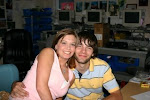Researcher Behind the Drug Gleevec
Dr. Brian J. Druker, 54, an oncologist at Oregon Health and Sciences University and a Howard Hughes Medical Investigator, is one of three winners this year of the Lasker-DeBakey Clinical Medical Research Award, often called the “American Nobel Prize.” Dr. Druker shared the honor with Nicholas B. Lydon, a former researcher for Novartis, and Charles L. Sawyers of Memorial Sloan-Kettering Cancer Center, “for the development of molecularly targeted treatments for chronic myeloid leukemia, converting a fatal cancer into a manageable chronic condition.” Here is an edited version of a conversation that took place last month in New York:

Q. WHAT WAS LIFE LIKE FOR PEOPLE WITH CHRONIC MYELOID LEUKEMIA, OR C.M.L., PRIOR TO YOUR RESEARCH?
A. Life was pretty miserable. If you were over 40, the main therapy was interferon, which prolonged life for maybe a year in perhaps 20 to 30 percent of patients. Interferon made the patients feel awful — like the worst flu. The only other hope was a bone-marrow transplant for younger patients. The problem there was that the death rate in the first year was 25 to 50 percent.
C.M.L. patients were always difficult to see because both of us knew that the clock was ticking and there was virtually nothing that we could do about it.
Q. It must have been depressing to be an oncologist under those circumstances.
A. When I started my training in the 1980s, you rarely cured people. You felt, “if I can give my patient extra time, I’ve been successful.” But I could see there was a transformation of cancer treatment on the horizon thanks to breakthroughs in biochemistry and genomics. I wanted to be part of that, which is why I was a physician-researcher.
The way I’d been trained, cancer was seen as something like a light switch that was stuck in an “on” position. You were given a baseball bat, which was chemotherapy, and told to knock the light out with the bat. I thought, “Why don’t we just try to figure out why the light is stuck on, then we can fix it without breaking everything.”
So I started my laboratory career studying the regulation of cell growth — what turns the switch on, what helps it shut down. And that’s how Gleevec is different from earlier chemotherapies, which basically poisoned every cell in the body in an attempt to kill the cancer. Gleevec turned off the light switch and only killed the cancer cells.
Q. How did the idea behind Gleevec first come up?
A. By the late 1980s, C.M.L., though rare, was a cancer that scientists knew a lot about. We knew, for instance that a chromosomal abnormality existed in every C.M.L. patient. We knew that this abnormality created an enzyme that caused the uncontrolled growth of cancer cells. If you put this enzyme into animals, they got leukemia.
So in 1988, Nick Lydon, who led a drug discovery group at a pharmaceutical company that eventually became Novartis, came to talk to me. He was interested in developing drugs to block a family of cellular enzymes implicated in several cancers. I said to him: “If you want to develop targeted chemotherapies, C.M.L. is the disease to study. We know the most about it — and, if we can figure out a way to block this enzyme, we can turn off the cancer switch.”
So in Nick’s lab at the pharmaceutical company, he began screening for agents that worked on C.M.L. He’d send me his best compounds. I found one, STI571, that was better than the others; it would kill every C.M.L. cell in a petri dish. By 1995, STI571 was a lead compound set for clinical development.
Q. So Gleevec was on its way?
A. Not quite. Gleevec was a completely different class of drugs than what was used against cancer. Most researchers thought it wouldn’t work. Then, in 1996, before we were about to go to trials, Nick’s company merged with another, and he left. Gleevec was now caught in the changeover. I lobbied with the new executives. After some ambivalence, they agreed to go forward with Phase 1 trials. I think they felt it wouldn’t work and they could get rid of us afterwards.
But during clinical trials we saw this miracle: Once the patients were up to effective doses, we got a 100 percent response rate.
Q. Had that ever happened before in a clinical trial?
A. No. Never. You’d see patients where interferon wasn’t working, and they’d been issued a death sentence. Suddenly, all their hopes for the future were restored, and, with minimal side effects! This was around 1999, and the Internet chat rooms were just beginning. Patients in the trials began talking to each other like they’d never done before. I’d see a patient, and I’d read about it on the Internet that night: “few side effects,” “100 percent response.” Patients would come to me and say, “My doctor has never heard of this drug.” I’d never written it up. I hadn’t presented the data. Their doctors thought I was a charlatan. For a lot of people, Gleevec was simply too good to be true. But these once-dying patients were getting out of bed, dancing, going hiking, doing yoga. The drug was amazing.
Now the drug company had to make another decision. They hadn’t made enough drugs for a large-scale Phase 2 trial. But patients knew about Gleevec, and many more wanted to be included in the trials. Through the Internet, they generated a petition that landed on the C.E.O.’s desk, asking for greater access. That’s how Phase 2 was rapidly expanded.
Q. YOUR FRIEND AVICE MEEHAN OF THE HOWARD HUGHES MEDICAL INSTITUTE SAYS THAT YOU HAVE THE MOST AMAZING PERSEVERANCE. IS THAT WHAT IT TOOK TO MAKE GLEEVEC HAPPEN?
A. I think I’m more perseverance than smarts. There’s a basketball player who says, “Hard work beats talent when talent doesn’t work hard.” Well, I work hard. I understood that this project was too good to give up on. My patients needed me to do something to help them. I did everything I could by getting them a drug I thought would work.
When the drug looked like it was finally going to be approved, I was interviewed by a reporter from People magazine, Alexandra Hardy. She asked, “Who are your good friends?” I said: “I don’t have any. I work, eat, sleep, go to the gym.” She said: “You’re pathetic. You’ve got no balance in your life.”
Well, there is now. Alexandra and I got married, and we have three wonderful children.
Q. Gleevec was ultimately proved effective against two cancers, right?
A. Ten. It’s now F.D.A.-approved for 10. Gleevec went to market for a small disease, 50,000 patients, and it later got tested for other things. It’s now used by 200,000 patients worldwide.
Q. Do you see any of that?
A. I don’t see a penny, though that never was an issue for me. When I obtained the compound, it was already patented. I wasn’t going to get to test it if I tried to put my mark on it. I wanted to work on it because I thought it was going to be the way to treat C.M.L.
You know, my patients were people who’d been told “to get their affairs in order” because they were going die soon. And now some of them play with grandchildren they’d thought they’d never live to see. That’s worth more than money.
----------------------------------------------------------------------------------------
What a man Dr Druker is. Every time I look at Steven, it's because of Dr Druker...... It's as simple as that. I would not be seeing my child, if not for him. Thats incredible, humbling and creates a depth of love for this man that goes beyond anything 'normal'.
This article made me realize again just how tenuous life is, how one man stood between my life now and a life that would have been just unimaginable....
Thank you, Dr Druker........ thank you!
love and light
Annie






.jpg)

2 comments:
What an amazing, humble man.
Thank you, Dr. Drucker, thank you!
Dr. Drucker, Thank you so very very much. You have saved my life. How can you Thank a person for working so hard to save your life? All I can say is I pray God's Blessings on you and your family always.We all that have been saved by Gleevec love you for what you have done for us!
Post a Comment